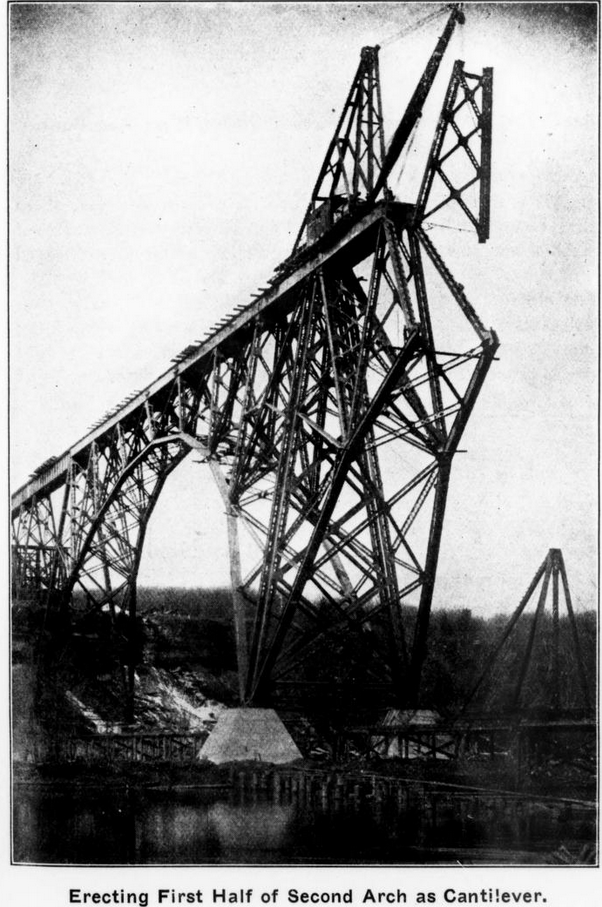- 1880: 54 miles completed from Chippewa Falls to Abbotsford, Wisconsin by Wisconsin and Minnesota Railroad
- 1885: 109 miles completed from St. Paul, Minnesota to Chippewa Falls, Wisconsin by predecessors of the Wisconsin Central Railroad
- 1888: W&M acquired by Wisconsin Central Railroad
- 1897: Wisconsin Central Railroad changed to Wisconsin Central Railway
- 1910: 12 mile realignment completed between Colfax and Howard, Wisconsin
- 1910: 19 miles completed between Owen and Spencer, Wisconsin by Wisconsin Central Railway, bypassing Abbotsford
- 1911: 18 mile realignment and new bridge completed between Withrow, Minnesota and New Richmond, Wisconsin
- 1916: Old St. Croix River Bridge removed
- 1934: Abbotsford-Curtiss segment abandoned
- 1938: Curtiss-Owen segment abandoned
- 1961: WC merged with Minneapolis, St. Paul & Sault Ste. Marie Railway and Duluth, South Shore & Atlantic Railway to form Soo Line Railroad
- 1980: Carnelian Junction to St. Paul segment abandoned and acquired by Minnesota DNR
- 1984: Soo Line Corporation created by Canadian Pacific Railway as a holding company
- 1987: Route sold to Wisconsin Central, Ltd
- 1993: Gateway Trail opens on St. Paul-Carnelian Junction segment
- 2001: Canadian National Railway acquires Wisconsin Central, Ltd
- 2001-Present: Canadian National operates the Withrow-Owen line as the Minneapolis Subdivision
11/21/21
View an article regarding the construction of this bridge.
This beautiful and quite impressive bridge was built in response to the need for a new bridge across the St. Croix River for the Soo Line.
The previous bridge, a deck and through truss bridge constructed in 1884 and was still structurally sound, but grades on either side of the bridge made it a problem.
As a result, the Soo Line employed a team of engineers to design the best solution. The top solution was a signature deck arch bridge, although this could be tricky and expensive to build.
Other ideas included the use of a large traditional girder viaduct, although this would prove to be problematic. A viaduct of this magnitude would require large piles at alternating 100 foot and 40 foot intervals, which proved to be cost prohibitive.
Another idea was the traditional viaduct, using large deck truss spans (similar to the Fort Dodge High Bridge) at the river spans.

Plan of the bridge, from the Railway Age-Gazette; Volume 51
However, after much consideration, the arch was chosen. Five large hinged deck arches, with span lengths of 350 feet would be built over 180 feet above the floor of the valley on a new cutoff, about 3/4 of a mile north of the existing bridge.
The first part of the bridge that makes it unique is the hinged deck arches. This means, at the base, the arch is wider than at the top.
To counter this, a unique deck system would be used. Girders were placed directly above the bracings supporting the arch. This allowed some cost cutting by reducing the need of stringers and floor beams.
While three hinged arches were typically considered undesirable for railroad use, this structure was built with a substantial depth above the arch. This counters the lack of rigidity. Also, the crown hinge features a very unique piece.
Friction plates, which lock together during a live load crossing make the bridge act like a two hinged arch, creating even more rigidity.
A final interesting detail is the lack of verticals above the arch, creating more of a Warren Truss appearance.
As Nathan Holth, author of Historicbridges notes; this lack of verticals is not surprising considering that Turner went on to invent the Turner Truss, which excluded verticals.

Construction of the bridge, from the Railway Age-Gazette; Volume 51
Work on the bridge began in early 1910, and was completed by late 1911. Because of the remote location, special considerations were taken when building this bridge.
This includes things such as special concrete chutes down the valley, false work construction for the outer spans and cantilevered construction of the center spans.
The massive blocks on which the bridge rest area created of concrete. In addition, a single jump span was added on the west end of the bridge. This I-Beam span was likely added in the 60s.
Approaches on each side are traditional deck girder viaduct spans. The Wisconsin side contains 2 towers, while the Minnesota side contains 4.
Upon completion, the bridge became an instant icon. Oftentimes considered to be one of the most unique railroad bridges in the nation, it is unfortunately quite hidden from the public eye.
On the Minnesota side, a series of well beat down trails lead to the riverbank from Arcola Trail.
On the Wisconsin side, views are extremely limited. Trespassing on the bridge is ABSOLUTELY forbidden and has led to fatalities in the years past.
The author has ranked this bridge as being nationally significant, due to the extremely unique design.
The photo above is an overview, from the Minnesota side. This specific angle is from a bluff near the first arch.
The historic photos come from The Transactions of The American Society of Civil Engineers, 1912.
| Upstream | Cedar Bend Drawbridge |
| Downstream | Wisconsin Central High Bridge |
